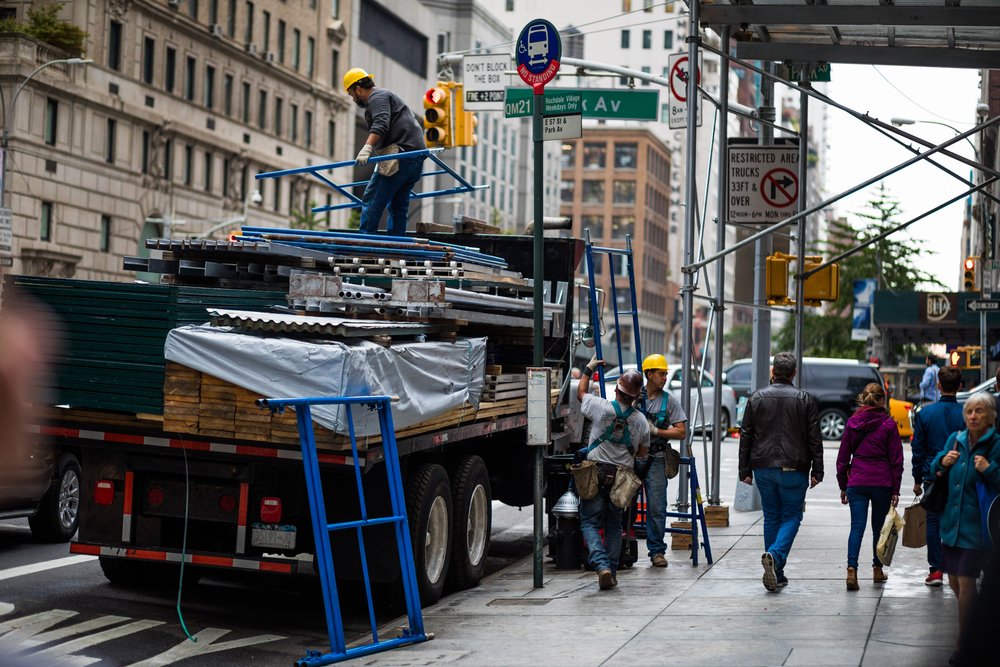December 5, 2017
Sidewalk Sheds: NYC’s Obstacle Course
By Jonathan Damashek
Posted in

Five pedestrians were injured earlier this month when a sidewalk shed collapsed onto a SoHo street in New York City. Pix11.com reported that the sidewalk shed, also called scaffolding, had been in front of a 12-story commercial office building before crashing down and injuring five people, one seriously. The shed had been installed in December 2016 because the building was undergoing restoration and repair of its facade. It is likely that wind gusts as high as 40-45 miles per hour were surging down the “urban wind tunnel” at the time.
While statistics regarding NYC pedestrian accidents and fatalities nearly always report vehicle-related incidents, not sidewalk shed incidents, New Yorkers are well aware that this accident was just the latest in a long string of similar sidewalk shed accidents. The New York Times reported that during the first six months of 2016, 55 pedestrians were killed by scaffolding collapses. In January of 2016, Crain’s New York had reported that there were approximately 190 miles of sidewalk sheds snaking through NYC, enough to wrap around Manhattan six times.
Dangerous Eyesores
According to the Department of Buildings, NYC contains nearly 9,000 sidewalk sheds that devour sidewalk space, cut off sunlight, hurt businesses and create safety hazards. Why so many? The City passed a law in 1980 requiring that older buildings undergo regular inspections to ensure that their concrete and bricks are secure and will not fall on pedestrians. Additional laws have since been passed. Per the Building Facade Safety Program, owners of buildings six stories or higher must have their buildings inspected by an architect or engineer licensed in New York State. The architect or engineer then must file a Local Law 11/98 Cycle 6 report of critical examination with the City’s Department of Buildings on the condition of the building’s facade. Today the scaffolding industry generates $1 billion annually. Only 20 percent of that goes for the sheds that are at street level. The rest pays for the scaffolding above the sheds and the workers who repair the building facades.
NYC laws require that a sidewalk shed be strong enough to support 300 pounds per square foot. This is twice the load required by any other city, but it ensures that a shed is strong enough to absorb the shock of a brick falling from 20 stories up. However, this strength also requires that a shed must have a column every eight feet to support the load of the shed.
While sidewalk sheds are supposed to ensure pedestrian safety, many people point out that they actually put pedestrians at risk for injury. With sidewalk space already at a premium in NYC, sidewalk sheds often create bottlenecks that force pedestrians to walk in the streets, risking being hit by a bicycle, car or bus. In addition, the sheds attract trash, pigeons, and homeless individuals, all of which hurt businesses and can create pedestrian safety hazards.
As Mayor Bill de Blasio said last year, sheds are “great for criminals as a place to hide and great for folks who want to throw their trash on top.” One NYC policeman discovered the truth of that statement long before Mayor de Blasio said it. In 2007, a police officer pursuing a criminal suspect suffered injuries when he slammed into a sidewalk shed pole in the dark.
Ubiquitous Presence
NYC residents and business owners loathe sidewalk sheds, mainly because they never seem to go away. Once one goes up, it tends to stay there “forever.” In 2015, the de Blasio administration removed eight miles of sheds from New York City Housing Authority properties where no active work was taking place. New York Governor Andrew Cuomo later signed a bill into law requiring the Housing Authority to remove all remaining dormant sheds on its properties. There is no such law, however, that applies to private property owners.
Not surprisingly, many private property owners have discovered that it is less expensive to keep a shed in place and pay building violation fees than to actually fix their building. A shed costs approximately $25,000 to erect, but only half of that amount is paid up-front. The rest is paid when the shed is taken down. The shed builder charges about $700 per month while the shed is in place. Contrast that with what could easily be $250,000 or more to fix the building.
Pedestrian Menace
For construction workers, shed building is less dangerous than many other types of work since most of it is done fairly close to the ground. The Department of Buildings reported that of the 199 construction accidents from January through June of 2015, only 11 resulted from sidewalk shed incidents and none resulted in a fatality.
Pedestrians are the people most at risk for being injured in a sidewalk shed accident. New York Labor Law 240/241, better known as the Scaffold Law, holds building owners and contractors completely liable for any accident, regardless of whether the injured person’s own inattention or negligence was partially to blame for his or her injuries.